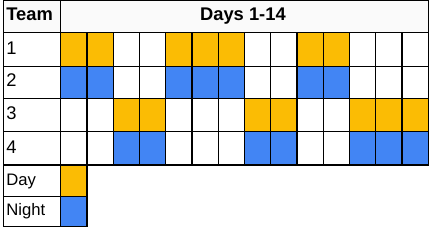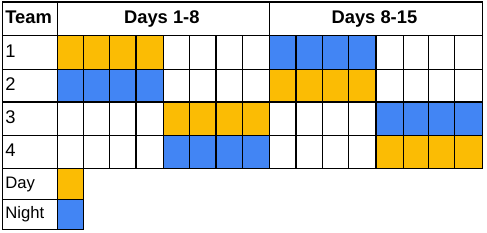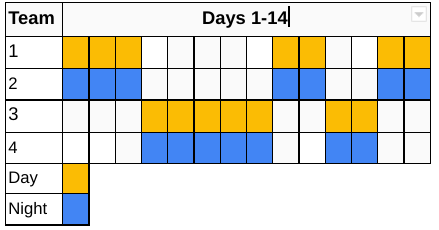A few too many under or overstaffed shifts. Angry team members who feel they’ve worked more night shifts in the past week than their colleagues. Labor costs through the roof to cover a high amount of overtime. No call, no show absences.
These issues, and more, are all byproducts of ineffective or broken shift planning procedures. To add insult to injury, your HR team probably spends way too much time every month navigating Excel spreadsheets and shift templates to get it right.
It doesn’t have to be this way. Employee management tools like Workforce.com are specifically designed to help guide you through the employee shift planning maze with your sanity intact.
In this guide, we’ll run you through some of the important steps to adopt that will make shedding blood, sweat, and tears on shift planning a thing of the past.
Planning a shift schedule
The best preparation you can do for shift planning is to know your business inside and out. Filling all your shifts is meaningless if done randomly. Here are the basics you should cover before assigning employees anywhere.
- Monitor demand: The most efficient work schedules take into account and even forecast the unique demand patterns of your company. When are you the busiest? Which nights are typically quiet? What regular events impact your foot traffic?
- Know your staff’s skills and abilities: This is where managerial knowledge becomes priceless. For example, knowing which workers are particularly good at handling customers or which ones are great at mentoring less experienced staff means you can always put the right people in the right place at the right time.
- Check safety regulations: Don’t overlook the practicalities. If you’re legally obligated to have a certain number of trained first-aiders on shift or need to maintain a ratio of staff to kids in a childcare setting, this needs to be baked into your schedule from the start.
By making these a core part of your shift management system, you’ll head off lots of future problems and build your schedules on rock-solid foundations.
Creating a shift schedule
Once you’re armed with intimate knowledge of your market conditions and predicted needs, it’s just a case of filling those empty shifts. With the right preparation, this part of the job should already be less intimidating, but here are the key things to keep in mind when you create a shift schedule.
- Know your staff availability: Assigning workers to shifts they cannot attend isn’t just inefficient for you, but it’s also frustrating for employees. Keep track of things like childcare arrangements, evening classes, and other important things in your workers’ lives. It allows you to get your schedule right the first time and shows them that you are taking notice of what matters to them.
- Communicate schedules quickly and accurately: Don’t leave employees in the dark about their shifts. The earlier you can inform them of their hours and the clearer the information is, the sooner you’ll identify any potential problems.
- Use the right tools: Many companies still use spreadsheets or even pen and paper for shift planning. Not only are these methods inflexible and prone to error, but they’re also hard to distribute and make it easy to lose track of details. Specialist shift planning and time tracking software can automate the hardest parts of scheduling and send up-to-date shift information to your workers’ phones in real-time.
- Always plan ahead: If you’ve taken all the previous steps into account, you should be able to confidently plan shift schedules at least two weeks in advance. Indeed, depending on where your business operates, you may be legally obligated to.
It can be a lot to take in, and for people new to shift planning, this is where the feeling of being overwhelmed can rear up again. Trust your data, be methodical, and even the most complex shift planning job can be broken down into manageable parts. Remember, you can always use scheduling software to automatically match employees to shifts based on your criteria.
Navigating predictive scheduling laws
If you manage shift workers and aren’t yet familiar with the concept of predictive scheduling laws, then you should brush up on the details even if you don’t operate in an area where they are in effect.
- What are predictive scheduling laws? These laws, also referred to as “Fair Workweek,” generally require shift workers to be given at least two weeks’ notice of their schedules and mandated rest periods between shifts. This means no “clopening,” where the same employee closes up at night and reopens the first shift the next day.
- Where are predictive scheduling laws in place? So far, one state (Oregon) and eight cities (San Francisco, Berkeley, Emeryville, Los Angeles, Chicago, New York City, Philadelphia, and Seattle) have passed predictive scheduling laws. Other states have bills coming up for debate. There are regional variations, so be sure to find out if these laws apply to any of your operations and, if so, what the specific requirements are.
The penalties for breaching these laws can be steep as they apply to each infraction. If you have multiple shift workers whose schedules do not comply, the fines will mount.
Careful planning and good recordkeeping will help ensure you are not exposed to unnecessary legal risks. As well as compiling your shift data automatically, employee scheduling software can be easily set up to catch infractions at the scheduling stage, eliminating the danger of falling foul of predictive scheduling legislation in your region.
Even if you are not legally required to follow these laws, it’s worth implementing some of the changes regardless. Studies have shown that workers who have advance notice of shifts and healthy breaks in between are more productive and stay with companies longer. If staff churn is an issue for you, taking a long-term approach to shift planning may help retain employees.
Managing time-off requests
No schedule is written in stone, of course, and employees will want to take personal time off. This doesn’t need to throw your shift planning into disarray, provided you have established a clear framework for managing employee time-off requests.
- Create a PTO policy: If your company doesn’t have an existing policy dictating the rules of personal time off, create one as a matter of urgency. It doesn’t have to be pages of legal language. A common-sense policy that lays out what is expected of both employees and the company is all you need.
- Implement a PTO policy: The crucial aspect of any PTO policy is notice periods. How much notice must employees give when booking time off? How quickly will the company approve or deny requests? These are the questions your policy should answer.
As a manager, keeping track of who has time off and when is vital. You don’t want to approve requests that leave you understaffed. Using scheduling software is the quick and easy way to avoid this, as it can automatically alert you whenever a time-off request creates a problem elsewhere on the schedule.
Dealing with staff shortages
Emergencies will happen, and staff will sometimes not be able to work for unpredictable reasons. While this is never ideal, staff coverage doesn’t have to be a problem. In fact, you will already have insulated your business against this issue by preparing properly for shift planning in the first place.
- Plan shifts using past data: You should already know when your highest sales periods are and when business is typically slow. Prioritize having backup staff for shifts that typically get slammed and cannot be understaffed.
- Communicate schedules early: You should also be in the habit of assigning shifts a few weeks in advance. This won’t save you from staff with transport problems on the day of or trips to the ER, but it will give employees the opportunity to alert you of unexpected occurrences that aren’t same-day emergencies. Even a day’s notice is better than no notice at all.
The most robust way of minimizing the impact of staff unavailability is to allow employees to swap shifts to plug these unexpected gaps.
Webinar: How to Schedule While Understaffed
Accommodating shift swaps
The idea of shift swaps, or shift replacements, can create anxiety for some managers. Giving employees the option to request shift replacements seems to fly in the face of shift planning. A shift trade policy can actually be a benefit to both the staff and the company when properly managed. Not only does it help fill the gaps caused by unexpected staff shortages, but 87% of workers now want to have more control over their work schedules.
- Create a shift replacement policy: As with a time-off policy, this doesn’t need to be complicated. Simply make clear the period in which shifts can be dropped and picked up by available employees, subject to managerial approval.
- Communicate the policy: Let your staff know that they are encouraged to request shift replacements if needed and won’t be penalized for doing so. Encourage them to use the process, and many of your last-minute staffing problems will fix themselves.
- Automate with technology: Shift replacement processes are only as effective as the level of automation invested into them. Instead of scrambling last minute to find replacement staff over text and email, replacements should be completed on a single, online system. When an employee requests coverage for a shift, their peers should automatically get notified and a bidding process should follow. – this workflow takes the logistics of seeking replacements off a manager’s plate.
- Retain managerial oversight: Just like booking time off, you should still approve requests carefully to make sure that appropriately skilled staff are swapping like-for-like shifts and that any trades don’t nudge workers into overtime.
If you still handle your shift planning using spreadsheets or pen and paper, then tracking and implementing shift trade requests does become exponentially more complicated. Scheduling tools make the process painless by allowing employees to make their requests digitally while empowering managers to offer open shifts to specific workers. Any changes or requests will be instantly available to both employees and management through notifications through employee communications software.
Now you can be confident in your shift planning
Shift planning is less intimidating when you approach it fully prepared and break it down into a methodical process. Taking control of shift planning doesn’t just make the life of managers less stressful, but it also results in more efficient use of your employees and a company culture that is less likely to be derailed by staffing issues.
There’s nothing involved in this process that can’t be done using manual techniques, but if the complexity still overwhelms you, consider shift planning software to ease the strain.
Shift planning software uses automation to facilitate the building of schedules and timesheets, making the organization of shift work much easier.
Try it out for yourself today, or, check out the free webinar below on the ROI of shift planning software, featuring exclusive research from Forrester Research:


















